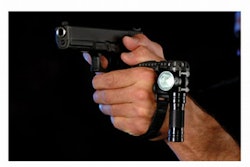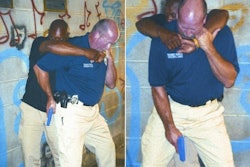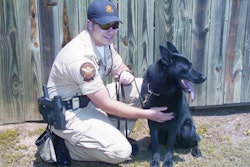Ever long for "the good old days?" I know that some of you do. You remember that public support for law enforcement was more apparent way back when in the 1970s. That may be true. But before you decide to switch places with yesterday's cop, it's important for you to know that you have much better tools and tactics than we did 30 years ago.
Let's look at four common police operations and talk about how they would have been handled differently and with different equipment 30 years ago.
Domestic Violence
Take a warm, loving look at the digital radio on your belt. Think about all the times you use it during the day. Your radio is your constant companion. It gives you information; it lets you disseminate information to your fellow officers; and you can use it to ask for backup or to call in a full "cavalry charge" when you need help.
In 1976, cops didn't have belt radios. So picture yourself working alone, or with just one partner. You answer a call to the fifth floor of some dump. On arrival, you use your car radio to let communications know that you have arrived. You then lock your car door, and you walk away from your only communications tool, the radio that is built into the dashboard of your patrol unit.
The building has "problem" written all over it. So you enter it cautiously, looking over the seedy types in the lobby. This fire trap looks like it was built back when inventor Elisha Otis was still alive. (Hint: He died in 1861.) The elevator looks like Elisha personally built it, and it's only big enough to hold a couple of six-year-old kids. So, you hike up the stairs.
Fifth floor. You hear the ruckus. You knock on the door. The sobbing, bloody wife opens it and bids you welcome. You enter and confront: the drunken Heavyweight Champion of the World.
The game is now afoot. But you are not. You are suddenly on your butt. You look up in time to see your partner flying through the air on his way to the north wall.
You're in trouble and you need backup. But remember, this is 30 years ago and your only radio is in the parking lot. Backup isn't coming unless some helpful citizen dials "0" and asks for the police. That's right, we didn't even have 911 service. You called the same operator that you called for directory assistance to call the cops.
OK. Enough about radios. Let's talk about the other tools that would not be on your belt 30 years ago.
This guy you're fighting is out of control. And he's real big and strong. You need a less-lethal option.
So you draw your beaver-tail sap-32 ounces of lead tightly packed into the business end of a flexible leather implement-or maybe you draw your straight hickory stick. Thirty years ago, we didn't have OC spray. We didn't have Tasers on our belts. We didn't even have side-handle batons, collapsible batons, or nunchakus.
So back then if your impact weapons didn't work, you had to go hands on with the guy. Often that meant the "bar-arm strangle" across the throat. That sometimes worked.
But if it didn't work and you didn't have backup, then you might face a situation so dangerous that you could end up trying to stop the guy with your six-shot .38, with 158-grain ball ammo.
Years ago, David Boyd, then-director of the Science and Technology Division of the National Institute of Justice, famously said, "Police still have the same choices Wyatt Earp had. They can talk a subject into cooperating, they can beat him into submission, or they can shoot him. What police need are better alternatives."
Today, we have those alternatives. We've got all kinds of neat "stuff" that our predecessors only dreamed of. Just turn through the pages of this magazine and you'll find a variety of modern equipment options that simply did not exist 30 years ago at the time of the scenario above.
The radio on your belt is a life saver. Need a little assistance? You can get all the cops in the entire county on the way at the push of a button.
Need to take down that drunken heavyweight champion? The fifth-generation Taser, the X-26, is likely your best bet. It'll let you stand back several yards and take care of business without getting your uniform dirty. You can even use the built-in video camera to record the whole incident so that you can later prove to your boss, the judge, the jury, the ACLU, and the media that you're not such a bad cop after all.
As for the bar-arm strangle, now you've got the LVNR (lateral vascular neck restraint) or the carotid control hold, and they are faster, safer, and more effective.[PAGEBREAK]
Riot Duty
Crowd control has never been an easy job for cops. But the equipment and the tactics are a lot better now than they were when Jimmy Carter was in the White House.
Back in 1976 if a riot or major civil disturbance broke out in your jurisdiction, you would have to put it down with batons, tear gas, and maybe water cannons.
The tools and tactics used today for riot control are much more effective and much less likely to get you seriously injured.
Today when your watch commander calls for a "Mobile Field Force," you can suit up in some serious protective gear. You already have your ballistic vest on because you wear it at all times. (You do, right?) But for crowd control you add on a Kevlar helmet with a face shield. These helmets are much better than the heavier helmets that we wore back in the day.
Crowd control is needed. So you-as part of an organized platoon of highly trained specialists-saddle up and save the day. Intimidation-through massive police presence, loud sirens, and bright lights-dissuades the local anarchists from turning your city into a riot zone.
And if intimidation doesn't work, you now have the tools to make even the most hardened troublemakers think twice about rioting. Your less-lethal weapons arsenal now includes a lot more than batons and tear gas. You have 12-gauge sock rounds, 40mm kinetic rounds, and chemical sprays of many types. Even Tasers are now being used by some agencies for breaking up unlawful assemblies. Funny how the demonstrators all run away after one or two of them take a brief zap.
Traffic Stop
The traffic stop is one of the most common and one of the most dangerous duties of police officers. That hasn't changed. Traffic stops were as hairy 30 years ago as they are today.
What has changed is the amount of help you have in determining which motorist is just a harried commuter heading home a little too fast and which motorist is a paroled felon.
Today when you make a traffic stop, you can run the plate in your in-car computer in seconds, and it will alert you immediately if something's not kosher. Thirty years ago, you would have to call in the plate, and it could take two or three minutes for a communications staff to tell you if the car was stolen.
You also have another great tool that your predecessors didn't have 30 years ago: the in-car video camera. I know that some of you guys don't like the cameras. You think of them as "big brother" watching your every move. But the camera is really great for covering your posterior.
Today when you make a traffic stop, you have the whole transaction on audio/video starting from the moment you turned on your overhead lights. This is good insurance. It makes it a lot harder for a citizen to make a false complaint about you.
Active Shooter
Interestingly enough, this is one area of police operations in which we have learned that the old ways were the best ways.
Here's the scenario. Let's say you've stopped at the Do-Drop Inn for a bite of lunch. But your meal is interrupted when you hear the emergency call of a robbery in progress at the supermarket. One last bite and a sip of your drink and you're out the door.
You arrive at the scene to the sounds of shots being fired inside the store. Screaming, panicked souls are bailing out of both doors. The shots continue.
Until recently, you would have surrounded the store and waited for SWAT. This is the tactical approach that was developed in the '70s, and it was what we did in such situations until six years ago after the Columbine school shooting.
Today, you should be training to execute "Immediate Action, Rapid Deployment" tactics to counter an active shooter. You don't wait for SWAT these days while people are being shot in the building you're standing in front of.
You take the lead. You assemble a team of the first six or eight responding officers. You arm yourselves with a couple of AR-15s or MP-5s and a couple of shotguns. You make entry. You find the bad guys. You engage. If they don't drop their weapons, you take 'em on, and you take 'em out (Sorry, I mean you "neutralize the threat.").
The ironic thing about this tactic is this is what cops did when they faced active shooters 40 years ago. It's a case of back to the future.
On August 1, 1966, nutcase Charles Whitman went up to the 27th floor of a tower on the campus of the University of Texas in Austin. He then used a variety of firearms to shoot 45 people. Whitman killed 14 and wounded 31. He was heroically stopped by Austin Police Department officers who ascended the tower during the shooting.
Consider this scene, with thanks to AssociatedContent.com:
"Austin police officers Jerry Day, Houston McCoy, and Ramiro Martinez, along with civilian Allen Crum and Public Safety officer W. A. Cowan all converged . . . Martinez went first, crawling toward the corner of the deck where he felt the shots were coming from. . . . As Whitman tried to move about, Crum saw him and shot . . . [Whitman] headed back to the corner that the other two officers were crawling toward, even as the bullets from the people firing at Whitman on the ground ricocheted around them. As Martinez rounded the corner, he began firing his .38. When Whitman tried to return fire, McCoy saw the white headband Whitman had tied around his head and shot him twice with his shotgun, knocking Whitman to the floor. Martinez grabbed the shotgun and ran up to Whitman, firing point blank into him."
These heroes were "first responders." We didn't have SWAT teams in those days. When we created SWAT teams to deal with "barricaded suspects" (and SWAT does that very well), somehow in a lot of places, we came to rely on SWAT for all major situations.
It took us too many "active shooter" tragedies, with too many innocent lives lost across the country over a period of years to finally figure it out. You don't just contain an active shooter and wait for the specialists.
In many situations, active shooters need to be handled by first responders. You're on the scene. You're on the spot. You're on the case.
One thing hasn't changed in 30 years or even in 130 years about your job. You have to have courage to do it. You have to go to the sound of the guns when everyone else is running away. You have to protect. You have to serve. That's something that will never change, regardless of improvements in equipment or tactics. It's the fundamental truth of being a law enforcement officer.
Capt. Greg Meyer retired in May from the Los Angeles Police Department. A consultant and expert witness on use-of-force issues, he is a member of the National Advisory Board of the Force Science Research Center and the Police Advisory Board.
















